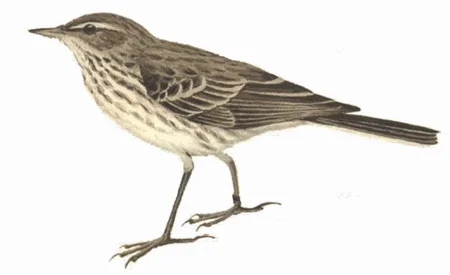
Water Pipit
[order] PASSERIFORMES | [family] Motacillidae | [latin] Anthus spinoletta | [UK] Water Pipit | [FR] Pitpit spioncelle | [DE] Bergpieper | [ES] Bisbita Alpina | [NL] Waterpieper
Subspecies
| Genus | Species | subspecies | Breeding Range | Breeding Range 2 | Non Breeding Range |
| Anthus | spinoletta | EU | c, w, s | n AF | |
| Anthus | spinoletta | blakistoni | |||
| Anthus | spinoletta | coutellii | |||
| Anthus | spinoletta | spinoletta |
Physical charateristics
American Pipits are small, brownish, streaked birds that are sparrow-like in appearance, but with much thinner bills. Males and females look alike. They are slender, with gray-brown backs and buff-colored breasts. During the breeding season, their breasts may be streaked or unstreaked, but outside the breeding season, they are typically more heavily streaked.
Listen to the sound of Water Pipit
[audio:http://www.aviflevoland.nl/sounddb/W/Water Pipit.mp3]
Copyright remark: Most sounds derived from xeno-canto
| wingspan min.: | 21 | cm | wingspan max.: | 26 | cm |
| size min.: | 16 | cm | size max.: | 17 | cm |
| incubation min.: | 13 | days | incubation max.: | 14 | days |
| fledging min.: | 13 | days | fledging max.: | 14 | days |
| broods: | 1 | eggs min.: | 3 | ||
| eggs max.: | 7 |
Range
Eurasia : Central, West, South
Habitat
American Pipits are open-country birds in all seasons. They breed in alpine areas, near seeps, streams, lakes, or wet meadows. During migration and winter, they come down into the lowlands and can be found on beaches, marshes, agricultural fields, short-grass prairies, and mudflats.
Reproduction
Nest site is in side of steep bank or hollow, well concealed by overhanging vegetation, sometimes at end of short tunnel. Nest is a cup of grass stems and leaves, and moss, with slight lining of finer leaves and a few hairs, building by female. 4-6 eggs, incubation 14-15 days by female only.
Feeding habits
Feeds on ground among tide wrack and rocks, rarely making short pursuits to catch insects in flight, frequently wades in sea water, following waves as thet retreat.
Conservation
This species has an extremely large range, and hence does not approach the thresholds for Vulnerable under the range size criterion (Extent of Occurrence <20,000 km2 combined with a declining or fluctuating range size, habitat extent/quality, or population size and a small number of locations or severe fragmentation). The population trend appears to be stable, and hence the species does not approach the thresholds for Vulnerable under the population trend criterion (>30% decline over ten years or three generations). The population size is extremely large, and hence does not approach the thresholds for Vulnerable under the population size criterion (<10,000 mature individuals with a continuing decline estimated to be >10% in ten years or three generations, or with a specified population structure). For these reasons the species is evaluated as Least Concern.
While there is some suggestion of declining numbers, American Pipits are currently widespread and common. Global warming may allow these birds to winter farther north than previously, but it also may reduce and fragment existing breeding areas. Forest clearing has probably increased American Pipit migration and wintering habitat, but the draining and destruction of wetlands and livestock grazing have had negative impacts on these habitats.

Migration
American Pipits are highly migratory and travel during the day in loose, straggling flocks. Fall migration begins in mid-September through October, when weather begins to deteriorate on the Arctic breeding grounds. American Pipits winter throughout the southern United States south to the tip of Central America. Birds return to the Arctic in the spring, with the peak migration occurring from late March through early May.
Distribution map

